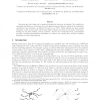Free Online Productivity Tools
i2Speak
i2Symbol
i2OCR
iTex2Img
iWeb2Print
iWeb2Shot
i2Type
iPdf2Split
iPdf2Merge
i2Bopomofo
i2Arabic
i2Style
i2Image
i2PDF
iLatex2Rtf
Sci2ools
132
click to vote
GIS
2004
ACM
2004
ACM
Efficient detection of motion patterns in spatio-temporal data sets
Moving point object data can be analyzed through the discovery of patterns. We consider the computational efficiency of detecting four such spatio-temporal patterns, namely flock, leadership, convergence, and encounter, as defined by Laube et al., 2004. These patterns are large enough subgroups of the moving point objects that exhibit similar movement in the sense of direction, heading for the same location, and/or proximity. By the use of techniques from computational geometry, including approximation algorithms, we improve the running time bounds of existing algorithms to detect these patterns.
Related Content
| Added | 11 Nov 2009 |
| Updated | 11 Nov 2009 |
| Type | Conference |
| Year | 2004 |
| Where | GIS |
| Authors | Joachim Gudmundsson, Marc J. van Kreveld, Bettina Speckmann |
Comments (0)

